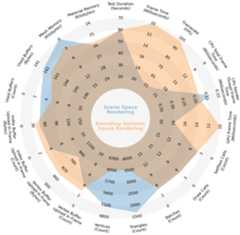- Notifications
You must be signed in to change notification settings - Fork0
Testing the performance of ray marching using different rendering spaces
danliukuri/RaymarchingRenderingSpacePerformanceTesting
Folders and files
| Name | Name | Last commit message | Last commit date | |
|---|---|---|---|---|
Repository files navigation
Using scene space rendering during ray marching involves rendering the entire scene by processing all objects, lights, and effects within the scene.
Figure 1. Process of ray marching using screen rendering space
(left: ray marching in rendering space, right: technical view of rendering result)
Using bounding volumes as space rendering during ray marching involves utilizing simplified shapes (bounding volumes) to approximate the spatial extent of complex objects.
Figure 2. Process of ray marching using bounding volumes rendering space
(left: ray marching in rendering space, right: technical view of rendering result)
Figure 3. Experiment scene (same rendering output for both approaches)
Figure 4. Experiment scene heatmap (screen rendering space)
Figure 5. Experiment scene heatmap (bounding volumes rendering space)
Figure 6. Rendering performance comparison radar chart
(average values calculated from data measured during 60 seconds)
About
Testing the performance of ray marching using different rendering spaces
Topics
Resources
Uh oh!
There was an error while loading.Please reload this page.





